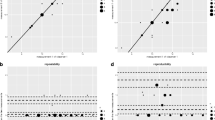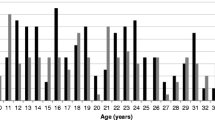Abstract
Estimation of chronological age from skeletal material is dependent upon estimation of maturational stage observed. Following completion of epiphyseal fusion, a transverse radio-opaque line, termed “epiphyseal scar”, may be observed in the region of the former growth plate. According to the literature, this line is likely to become obliterated shortly after completion of epiphyseal fusion. Consequently, presence of an epiphyseal scar has been interpreted as an indication of recent epiphyseal fusion; however, this has not been validated by quantitative research. A study was undertaken to determine persistence of the epiphyseal scars in a cross-sectional population of adults between 20 and 50 years of age. This study examined 1,216 radiographs of proximal and distal tibiae from both sexes and sides of the body. This study suggested that 98.05 % of females and 97.74 % of males retained some remnant of the epiphyseal scar at the proximal tibia whilst 92.72 % of females and 92.95 % of males retained some remnant of the epiphyseal scar at the distal tibia. General linear model (GLM) analysis determined that chronological age accounted for 2.7 % and 7.6 % of variation in persistence of the epiphyseal scar at the proximal and distal tibiae, respectively. This study suggests that obliteration of the epiphyseal scar is not as dependent on chronological age as previously thought. It is, therefore, recommended that this feature not be used as an indicator of chronological age during forensic age assessment.






Similar content being viewed by others
References
Khan KM, Miller BS, Hoggard E, Somani A, Sarafoglou K (2009) Application of ultrasound for bone age estimation in clinical practice. J Pediatr 154(2):243–247
Greulich WW, Pyle SI (1959) Radiographic atlas of skeletal development of hand and wrist. Stanford University Press, Palo Alto
Pyle SI, Hoerr NL (1969) A radiographic standard of reference for the growing knee. Charles C. Thomas, Springfield
Tanner JM, Healy MJR, Goldstein H, Cameron N (2001) Assessment of skeletal maturity and prediction of adult height (TW3 method). Saunders, London
Mentzel H-J, Vilser C, Eulenstein M, Schwartz T, Vogt S, Böttcher J, Yaniv I, Tsoref L, Kauf E, Kaiser W (2005) Assessment of skeletal age at the wrist in children with a new ultrasound device. Pediatr Radiol 35(4):429–433
Dedouit F, Bindel S, Gainza D, Blanc A, Joffre F, Rougé D, Telmon N (2008) Application of the Iscan Method to two- and three-dimensional imaging of the sternal end of the right fourth rib. J Forensic Sci 53(2):288–295
İşcan MY, Loth SR, Wright RK (1984) Metamorphosis at the sternal rib end: a new method to estimate age at death in white males. Am J Phys Anthropol 65(2):147–156
Acsadi G, Nemerski J (1970) History of human life span and mortality. Akademiai Kiado, Budapest
Brooks S, Suchey J (1990) Skeletal age determination based on the os pubis: a comparison of the Acsádi–Nemeskeri and Suchey–Brooks methods. Hum Evol 5:227–238
Ritz-Timme S, Cattaneo C, Collins MJ, Waite ER, Schütz HW, Kaatsch HJ, Borrman HIM (2000) Age estimation: the state of the art in relation to the specific demands of forensic practise. Int J Legal Med 113(3):129–136
Koc A, Karaoglanoglu M, Erdogan M, Kosecik M, Cesur Y (2001) Assessment of bone ages: is the Greulich–Pyle method sufficient for Turkish boys? Pediatr Int 43(6):662–665
Bull RK, Edwards PD, Kemp PM, Fry S, Hughes IA (1999) Bone age assessment: a large scale comparison of the Greulich and Pyle, and Tanner and Whitehouse (TW2) methods. Arch Dis Child 81(2):172–173
Cole AJL, Webb L, Cole TJ (1988) Bone age estimation: a comparison of methods. Br J Radiol 61(728):683–686
O' Connor JE, Bogue C, Spence LD, Last J (2008) A method to establish the relationship between chronological age and stage of union from radiographic assessment of epiphyseal fusion at the knee: an Irish population study. J Anat 212(2):198–209
Baumann U, Schulz R, Reisinger W, Heinecke A, Schmeling A, Schmidt S (2009) Reference study on the time frame for ossification of the distal radius and ulnar epiphyses on the hand radiograph. Forensic Sci Int 191(1–3):15–18
Groell R, Lindbichler F, Riepl T, Gherra L, Roposch A, Fotter R (1999) The reliability of bone age determination in central European children using the Greulich and Pyle method. Br J Radiol 72(857):461–464
Ding M, Odgaard A, Linde F, Hvid I (2002) Age-related variations in the microstructure of human tibial cancellous bone. J Orthop Res 20(3):615–621
McCalden RW, McGeough JA, Court-Brown CM (1997) Age-related changes in the compressive strength of cancellous bone. The relative importance of changes in density and trabecular architecture. J Bone Joint Surg Br 79(3):421–427
Cope Z (1920) Fusion-lines of bones. J Anat 55:36–37
Schaefer MC, Black SM (2005) Comparison of ages of epiphyseal union in North American and Bosnian skeletal material. J Forensic Sci 50(4):777–784
Hoerr NL, Pyle SI, Francis CC (1962) Radiographic atlas of skeletal development of the foot and ankle: a standard of reference. Charles C Thomas, Springfield
Crowder CM, Austin D (2005) Age ranges of epiphyseal fusion in the distal tibia and fibula of contemporary males and females. J Forensic Sci 50(5):1001–1007
Todd TW (1930) The anatomical features of epiphyseal union. Child Dev 1(3):186–194
Todd TW (1930) Comparative youth: the physical aspect. Child Dev 1(2):79–89
Cameriere R, Cingolani M, Giuliodori A, De Luca S, Ferrante L (2012) Radiographic analysis of epiphyseal fusion at knee joint to assess likelihood of having attained 18 years of age. Int J Legal Med:1–11
Kausar A, Varghese PS (2012) Estimation of age by epiphyseal union of the knee joint by radiological examination in Bijapur district. Int J Biomed Adv Res 3(2):132–138
Weiss E, DeSilva J, Zipfel B (2012) Brief communication: radiographic study of metatarsal one basal epiphyseal fusion: a note of caution on age determination. Am J Phys Anthropol 147(3):489–492
Ostrum RF (2001) Techniques of retrograde intramedullary nailing of the femur. Tech Orthop 16(4):354–360
Ostrum RF, Storm S, White K (2009) The epiphyseal scar as a radiographic landmark for retrograde femoral nail insertion. Am J Orthop 38(9):442–444
Clement H, Heidari N, Kosuge D, Grechenig W, Tesch N, Weinberg A (2011) Anatomical structures at risk with the proud retrograde femoral nail. Arch Orthop Trauma Surg:1–6
Brumback RJ (1996) The rationales of interlocking nailing of the femur, tibia, and humerus: an overview. Clin Orthop 324:292–320
The Scottish Government (2010) Relative poverty across Scottish local authorities. The Scottish Government. http://www.scotland.gov.uk/Resource/Doc/322580/0103786.pdf. Accessed 7/2/12 2012
Walker RA, Lovejoy CO (1985) Radiographic changes in the clavicle and proximal femur and their use in the determination of skeletal age at death. Am J Phys Anthropol 68(1):67–78
Kjar I (1974) Skeletal maturation of the human fetus assessed radiographically on the basis of ossification sequences in the hand and foot. Am J Phys Anthropol 40(2):257–275
Ameen S (2005) Harris lines of the tibia across centuries: a comparison of two populations, medieval and contemporary in Central Europe. Skeletal Radiol 34(5):279–284
Velasco-Vázquez J, Martín-Rodríguez E, Arnay-de-la-Rosa M, González-Reimers E, Castilla-García A (1999) Harris lines in the prehispanic population of Gran Canaria (Canary Islands). Hum Evol 14(3):169–173
Cross N, Hillman L, Allen S, Krause G, Vieira N (1995) Calcium homeostasis and bone metabolism during pregnancy, lactation, and postweaning: a longitudinal study. Am J Clin Nutr 61(3):514–523
Porac C, Coren S, Duncan P (1980) Life-span age trends in laterality. J Gerontol 35(5):715–721
Ozener B (2012) Extreme behavioral lateralization and the remodeling of the distal humerus. Amer J Hum Biol:436–440
Blackburn A (2011) Bilateral asymmetry of the humerus during growth and development. Am J Phys Anthropol 145(4):639–646
Auerbach BM, Ruff CB (2006) Limb bone bilateral asymmetry: variability and commonality among modern humans. J Hum Evol 50(2):203–218
Ruff CB (1981) Bilateral asymmetry in cortical bone of the humerus and tibia—sex and age factors. Hum Biol 53(1):69
Molnar P (2006) Tracing prehistoric activities: musculoskeletal stress marker analysis of a stone-age population on the Island of Gotland in the Baltic sea. Am J Phys Anthropol 129(1):12–23
Hughes C, Heylings DJA, Power C (1996) Transverse (Harris) lines in irish archaeological remains. Am J Phys Anthropol 101(1):115–131
Langley-Shirley N, Jantz RL (2010) A Bayesian approach to age estimation in modern Americans from the clavicle. J Forensic Sci 55(3):571–583
Kreitner KF, Schweden FJ, Riepert T, Nafe B, Thelen M (1998) Bone age determination based on the study of the medial extremity of the clavicle. Eur Radiol 8(7):1116–1122
Schmeling A, Grundmann C, Fuhrmann A, Kaatsch HJ, Knell B, Ramsthaler F, Reisinger W, Riepert T, Ritz-Timme S, Rösing F, Rötzscher K, Geserick G (2008) Criteria for age estimation in living individuals. Int J Legal Med 122(6):457–460
Schulz R, Mühler M, Mutze S, Schmidt S, Reisinger W, Schmeling A (2005) Studies on the time frame for ossification of the medial epiphysis of the clavicle as revealed by CT scans. Int J Legal Med 119(3):142–145
Mühler M, Schulz R, Schmidt S, Schmeling A, Reisinger W (2006) The influence of slice thickness on assessment of clavicle ossification in forensic age diagnostics. Int J Legal Med 120(1):15–17
Kellinghaus M, Schulz R, Vieth V, Schmidt S, Schmeling A (2010) Forensic age estimation in living subjects based on the ossification status of the medial clavicular epiphysis as revealed by thin-slice multidetector computed tomography. Int J Legal Med 124(2):149–154
Author information
Authors and Affiliations
Corresponding author
Rights and permissions
About this article
Cite this article
Davies, C., Hackman, L. & Black, S. The persistence of epiphyseal scars in the adult tibia. Int J Legal Med 128, 335–343 (2014). https://doi.org/10.1007/s00414-013-0838-3
Received:
Accepted:
Published:
Issue Date:
DOI: https://doi.org/10.1007/s00414-013-0838-3




